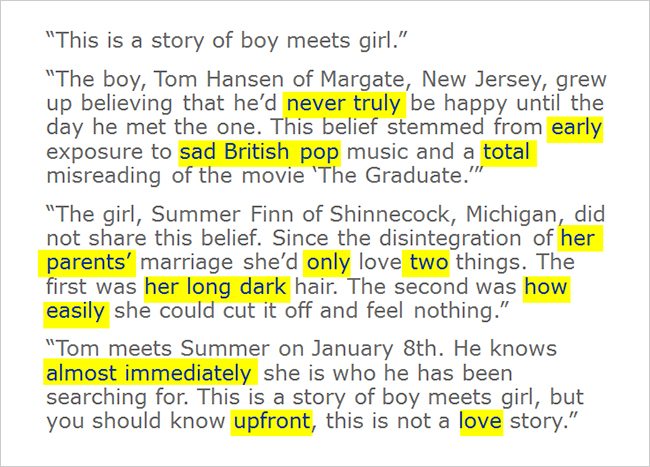Business communicators can take lessons away from all forms of storytelling.
One of my favorite go-to exercises for our storytelling workshop leans on the movie, “500 Days of Summer.” A voice with James Earl Jones-like command delivers a narration that sets the stage for the movie and what proved to be Zooey Deschanel’s coming out party.
Let’s examine the words, which I’ve broken down into four passages:
“This is a story of boy meets girl.”
Opening with a cliché isn’t exactly from the Creative Writing 101 handbook. It works here because the cliché is about to be turned inside out.
“The boy, Tom Hansen of Margate, New Jersey, grew up believing that he’d never truly be happy until the day he met the one. This belief stemmed from early exposure to sad British pop music and a total misreading of the movie ‘The Graduate.’”
“The girl, Summer Finn of Shinnecock, Michigan, did not share this belief. Since the disintegration of her parents’ marriage she’d only love two things. The first was her long dark hair. The second was how easily she could cut it off and feel nothing.”
“Tom meets Summer on January 8th. He knows almost immediately she is who he has been searching for. This is a story of boy meets girl, but you should know upfront, this is not a love story.”
With paths of Tom and Summer intersecting, we know a train wreck will ensure. This is also when the opening cliché gets turned inside out with the closing line, “This is not a love story.”
I encourage you to take a listen to the narration which only lasts 93 seconds.
Business communications — and particularly PR — often fall into the trap of telling the audience, not showing the audience.
For example, every company wants to be perceived as innovative, so the communications effort typically shouts to the world that “We’re innovative.”
Adjectives don’t win over the audience much less shape perceptions. Stories do, which brings us back to “showing” a company’s innovative approach.
In the kick-off narration for “500 Days Summer,” I’ve highlighted the adjectives and adverbs.

This exercise reveals that adjectives and adverbs have a place in narrative. They add texture (not showy). But it’s the story, the showing, that should do the heavy lifting.
One final point —
In business communications, there’s a tendency to jump to the point as quickly as possible, which can mean cutting out what might be viewed as superfluous details. Yet, these same details can help shape and bring a certain realness to the communications.
In the “500 Days of Summer” opener, what happens if we eliminate the hometowns of Tom Hansen and Summer Finn? The story still holds together. It still shows us how each individual is wired. But we lose a touch of realness in the fiction transport.
Even though business communications by definition is non-fiction — let’s save the issue of “spin” for another day — the cynical nature of today’s audience means that they don’t automatically believe everything they read or hear. That’s why the details are important. They deliver cues to the audience that they should believe the communications.
Scrutinize any feature story in business publications like a Fortune or Fast Company, and you’ll discover that such details make the final cut. Journalists want readers to believe their stories as well.




